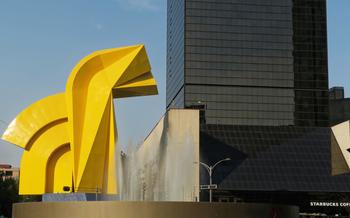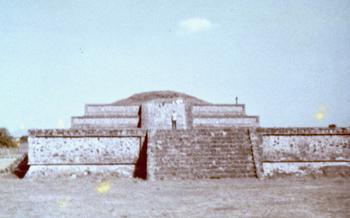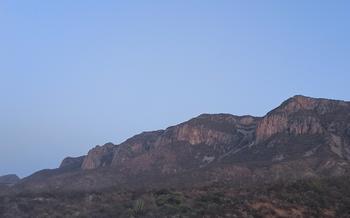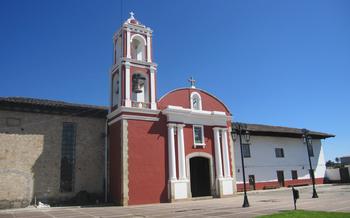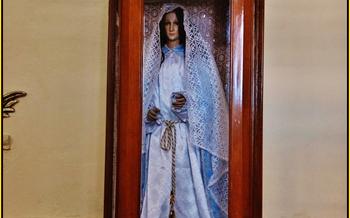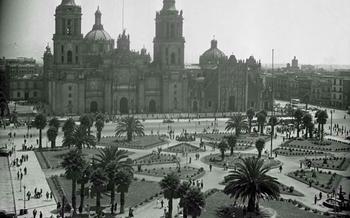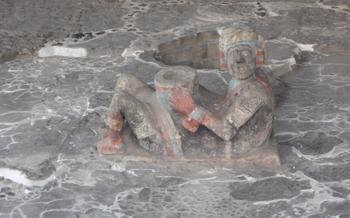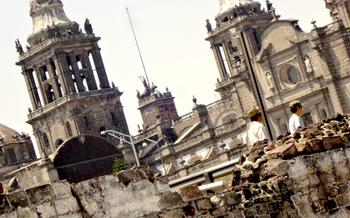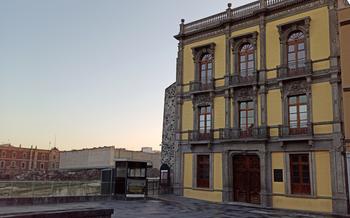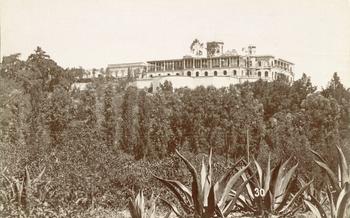
Museo del Calendario
- Exploring the History of Timekeeping
- Interactive Exhibits and Displays
- Unveiling the Secrets of the Calendar Stone
- The World of Ancient Mesoamerican Cultures
- A Unique Museum Experience
- Planning Your Visit
- Unveiling the Mysteries of the Night Sky
- Educational Programs and Workshops
- A Place for Reflection and Inspiration
- Exploring Queretaro's Cultural Heritage
- Inspiring Future Generations
- Insider Tip: Hidden Gems of the Museum
Exploring the History of Timekeeping
The Museo del Calendario takes visitors on a journey through the history of timekeeping, showcasing the development of calendars from ancient civilizations to the present day. The museum highlights the ingenuity and precision of ancient civilizations, such as the Mayans and Aztecs, who developed sophisticated calendars based on astronomical observations. Visitors can learn about the role of astronomy in timekeeping and the influence of Spanish colonization on the Mexican calendar. The museum also explores the evolution of modern calendars, including the Gregorian calendar, which is used worldwide today.
Interactive Exhibits and Displays
The Museo del Calendario is not just a place to learn about the history of timekeeping; it's also an interactive experience that engages visitors of all ages. Hands-on activities, multimedia presentations, and digital displays bring the exhibits to life, allowing visitors to explore the world of calendars and timekeeping in a fun and engaging way.
Historical artifacts and replicas provide a tangible connection to the past, while guided tours and workshops offer deeper insights into the significance of the exhibits. The museum's interactive approach encourages visitors to actively participate in the learning process, making it an unforgettable experience for everyone.
Visitors can try their hand at creating their own calendars, using ancient techniques and materials. They can also explore the museum's planetarium and observatory, where they can learn about ancient astronomical observations and the connection between astronomy and timekeeping.
With its interactive exhibits and engaging displays, the Museo del Calendario is a place where visitors can not only learn about the history of timekeeping but also experience it firsthand.
Unveiling the Secrets of the Calendar Stone
The Aztec calendar stone, also known as the Sun Stone, is a monumental masterpiece that holds a prominent place in the Museo del Calendario. Carved from a single block of volcanic rock, this colossal sculpture is a testament to the ingenuity and astronomical knowledge of the ancient Aztecs. Its intricate carvings depict the Aztec calendar system, which was based on a 365-day solar year and a 260-day ritual calendar.
The calendar stone is a marvel of symbolic and iconographic representation. The central figure is the face of the sun god, Tonatiuh, surrounded by four smaller faces representing the previous four suns that ruled the world before the current one. The outer ring features 20 glyphs representing the 20 days of the Aztec month, while the inner ring shows the 18 months of the Aztec year. The stone also includes various astronomical symbols, such as stars, planets, and constellations, revealing the Aztecs' advanced understanding of celestial bodies and their movements.
The calendar stone served as a powerful symbol of time and the cosmos in Aztec society. It played a crucial role in religious ceremonies, agricultural practices, and the regulation of everyday life. By studying this magnificent artifact, visitors gain insights into the complex worldview and sophisticated mathematical system of the Aztecs, marveling at their ability to track time and predict celestial events with remarkable accuracy.
The World of Ancient Mesoamerican Cultures
The Museo del Calendario offers a fascinating glimpse into the lives and beliefs of the Aztecs, Mayans, and other Mesoamerican civilizations. Timekeeping held immense importance in these cultures, as it was closely intertwined with their religious ceremonies and rituals. The museum's exhibits showcase intricate calendars used to predict agricultural cycles, celestial events, and significant religious festivals. Visitors can explore the symbolic meanings and astronomical principles behind these calendars, gaining insights into the sophisticated knowledge and ingenuity of ancient Mesoamerican societies. The museum also highlights the enduring influence of these calendars on modern-day timekeeping, demonstrating the enduring legacy of ancient Mesoamerican cultures on our contemporary understanding of time.
A Unique Museum Experience
The Museo del Calendario is not just any ordinary museum; it's a captivating blend of history, culture, and technology that offers a truly unique and immersive experience. The museum's striking architecture, designed by renowned Mexican architect Pedro Ramírez Vázquez, complements the historical significance of the site, creating a harmonious fusion of past and present.
Inside, visitors are greeted with a stunning array of interactive exhibits and displays that bring the history of timekeeping to life. Multimedia presentations, digital displays, and hands-on activities engage visitors of all ages, allowing them to explore the development of calendars and timekeeping systems across various cultures. Historical artifacts and replicas, carefully curated and presented, provide a tangible connection to the past, offering a glimpse into the ingenuity and craftsmanship of ancient civilizations.
Guided tours and workshops conducted by knowledgeable and passionate guides enhance the museum experience, providing visitors with deeper insights into the intricacies of timekeeping and the cultural significance of calendars. These interactive sessions encourage engagement, foster learning, and create a lasting impression on visitors, leaving them with a profound appreciation for the role of time in shaping human history.
Planning Your Visit
The Museo del Calendario is conveniently located in the heart of Queretaro, making it easily accessible for visitors. The museum is open from Tuesday to Sunday, with extended hours on weekends. Admission fees are reasonable, and discounted rates are available for students, seniors, and groups. Guided tours are offered in English and Spanish, providing an in-depth exploration of the museum's exhibits and artifacts.
To make the most of your visit, plan to spend at least two hours at the museum. Allow ample time to explore the interactive exhibits, watch the multimedia presentations, and admire the historical artifacts. Guided tours typically last around an hour and provide a comprehensive overview of the museum's highlights. If you have limited time, consider joining a guided tour to ensure you don't miss any of the essential exhibits.
Unveiling the Mysteries of the Night Sky
The Museo del Calendario boasts a state-of-the-art planetarium and observatory, offering visitors a chance to explore the celestial wonders that have fascinated humans for centuries. Regular stargazing sessions and astronomy workshops provide an immersive experience, allowing visitors to learn about the constellations, planets, and other celestial objects visible from Queretaro's night sky. Through these programs, the museum invites visitors to delve into the ancient astronomical observations that influenced the development of calendars and timekeeping systems. The connection between astronomy and timekeeping becomes tangible as visitors witness the movement of celestial bodies and their impact on the measurement of time.
Educational Programs and Workshops
The Museo del Calendario is not just a place to admire historical artifacts; it also serves as an educational hub for people of all ages. The museum offers a range of programs and workshops designed to engage students and foster their interest in history, science, and culture.
One of the highlights of the museum's educational programs is the interactive workshop on calendar making. Participants get hands-on experience in creating their own calendars, using traditional techniques and materials. This workshop provides a unique opportunity to understand the complexities of ancient calendar systems and appreciate the ingenuity of our ancestors.
The museum also hosts astronomy workshops, where visitors can learn about the night sky, constellations, and the role of astronomy in ancient cultures. These workshops often include stargazing sessions, allowing participants to observe the wonders of the universe through telescopes.
School groups are particularly encouraged to visit the museum and take advantage of its educational offerings. Guided tours are available for groups of all ages, providing students with a deeper understanding of the museum's exhibits and the history of timekeeping.
Through its educational programs and workshops, the Museo del Calendario plays a vital role in promoting science education and cultural awareness among the younger generation. It is a place where children and adults alike can learn, explore, and discover the fascinating world of time and its significance in human history.
A Place for Reflection and Inspiration
Museo del Calendario offers visitors a sanctuary for contemplation and introspection. Amidst the interactive exhibits and historical artifacts, there is a palpable sense of tranquility that invites visitors to pause and reflect. The museum's serene atmosphere encourages visitors to connect with the past, learn from history, and appreciate the significance of time.
Through its exhibits, the museum presents a narrative of human ingenuity and the pursuit of understanding the cosmos. Visitors are invited to contemplate the cyclical nature of time and the interconnectedness of different cultures. The museum's displays provide insights into the lives of ancient civilizations and their relationship with the celestial bodies.
The museum's serene environment and thought-provoking exhibits inspire visitors to appreciate the present moment and reflect on the passage of time. It is a place where visitors can reconnect with their own sense of purpose and find inspiration in the wisdom of the past. The museum's mission to promote cultural understanding and appreciation extends beyond its walls, leaving a lasting impact on visitors long after their visit.
Exploring Queretaro's Cultural Heritage
The Museo del Calendario is. Queretaro boasts a rich tapestry of history, proudly displaying its colonial architecture, cobblestone streets, and vibrant plazas. The city is home to numerous museums, art galleries, and historical landmarks, inviting visitors to delve into its captivating past.
The Museo del Calendario plays a pivotal role in showcasing Queretaro's cultural heritage. As the city's cultural epicenter, it offers a unique perspective on the region's history, traditions, and beliefs. Visitors can immerse themselves in the city's vibrant culture by attending traditional festivals, exploring local markets, and savoring the flavors of Queretaro's delectable cuisine.
Other notable cultural attractions in Queretaro include the Museo Regional de Querétaro, which houses an extensive collection of pre-Hispanic artifacts and colonial art, and the Templo de San Francisco, a magnificent 16th-century church renowned for its intricate architectural details. The city's vibrant street art scene further adds to its cultural allure, with colorful murals adorning the walls of buildings and alleyways, showcasing the creativity and artistry of local talent.
Queretaro's cultural heritage is deeply intertwined with the Museo del Calendario, making it an indispensable destination for anyone seeking to understand and appreciate the city's unique identity. The museum serves as a gateway to the city's rich cultural tapestry, inviting visitors to explore its historical treasures, embrace its traditions, and immerse themselves in its vibrant contemporary arts scene.
Inspiring Future Generations
The Museo del Calendario is not just a place to learn about the past; it is also a place to inspire future generations. The museum's educational programs and initiatives are designed to engage young people in learning about history and culture in a fun and interactive way. Through hands-on activities, interactive learning experiences, and workshops on calendar making and timekeeping, the museum fosters creativity, critical thinking, and a passion for learning. By inspiring young minds, the museum plays a crucial role in shaping the leaders, innovators, and thinkers of tomorrow.
Insider Tip: Hidden Gems of the Museum
Beyond the main exhibits, the Museo del Calendario holds hidden treasures waiting to be discovered. One secret spot is the rooftop terrace, offering panoramic views of Queretaro's cityscape. Here, visitors can escape the crowds and enjoy a moment of tranquility while admiring the city's landmarks. Another hidden gem is the museum's library, which houses a collection of rare books and manuscripts on timekeeping and astronomy. Visitors can delve into the depths of knowledge and uncover forgotten stories about the history of time.
Exploring these hidden gems adds a unique dimension to the museum experience. It's like embarking on a treasure hunt, discovering secrets that enrich the understanding of timekeeping and its significance. Whether it's the breathtaking views from the rooftop terrace or the forgotten stories in the library, these hidden gems offer a glimpse into the museum's dedication to preserving and sharing knowledge. So, take your time, explore beyond the main exhibits, and discover the hidden treasures that await you at the Museo del Calendario.
